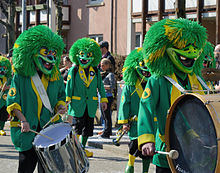Old Shrovetide
The old carnival - even peasant carnival or alemannisch Buurefasnacht - is a regional carnival date in which the carnival until Sunday after Ash Wednesday , the Funkensonntag ends.
history
The old Mardi Gras falls into the beginning of today's Lent . The different date is usually explained with the introduction of the Gregorian calendar ; However, this is not the case, rather the old Carnival is a holdover from the original beginning of Lent. The new, earlier starting date was brought forward at the Synod of Benevento in 1091 because the Sundays had been removed from the fasting requirement and the days that were now missing had to be added before the previous start in order to come back to 40 days.
In some areas, especially in Vorarlberg , Switzerland and southwest Germany ( Wiiler Buurefasnacht , Sulzburg ), the old carnival has been preserved in rural customs (in contrast to the men's carnival on the official carnival date) or it was recorded in an organized form after the Second World War (such as in Hauingen , a district of Lörrach , where documents from the years 1858 and 1930 are available, which prove that the “Buurefasnacht” was celebrated there by the population in those years); in other areas, e.g. B. north of Lake Constance and in Liechtenstein , it only exists as an appointment for individual customs such as spark or disc fire .
Trivia
The fact that the old carnival comes after the men's carnival also explains the humorous Alemannic saying that someone “ comes after it like the old carnival”, which means nothing other than that someone is quite or hopelessly late.
See also
Web links
- Easter Lent in the church festival calendar of the Archdiocese of Cologne
Individual evidence
- ↑ Official Announcement sheet for the grand ducal district offices of Lörrach, Müllheim, Schopfheim and Schönau; Chronicle of the Musikverein Hauingen since 1927, Hauinger Schnitzelbank 1930
